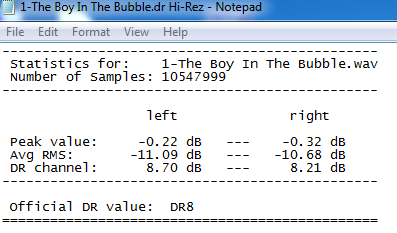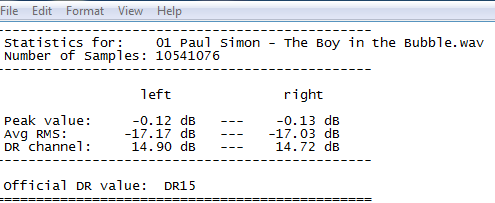Thanks Julf...
When is Hi-Res not really Hi-Res?
- Thread starter Kippyy
- Start date
You are using an out of date browser. It may not display this or other websites correctly.
You should upgrade or use an alternative browser.
You should upgrade or use an alternative browser.
I don't find these tools useful. They use an averaging window that get significantly change the reported dynamic range. In addition, they can get fooled by noise. We can hear music through the noise but the measurement tools like this can't. The reported dynamic range as a result are much lower than reality.I used the TT Dynamic Range Meter. This meter only analyzes .wav file at 16/44. So, I converted Boy in the Bubble from Hdtracks to 16/44 .wav and this is what I got:
View attachment 6758
Here is the original CD release of Boy in the Bubble:
View attachment 6759
Thanks Bruce. One of the concerns I have about high sampling rate music is that the person who mixed it may not be hearing what is going on in the ultrasnoics either! Why else would they not catch that sudden drop in frequency response?Thought i'd post a file of the Graceland album. What you have to do is to zoom in on where you think the problem area is. You can see the dip actually occurs before 22.05k. If this was an upsampled file, you would see a steeper cutoff at 22.05k and go below -100dB.
View attachment 6752
This becomes even more challenging when designing lossy audio codecs where you have to have a perceptual model of the hearing system. Surely such a model would have no response past 20,000 Hz or so. Yet if the sampling rate is 96 Khz, you need the model to tell you what to do all the way up to 48,000 Hz! I remember a guy presenting such a codec at AES conference and being completely stomped by this question.
It is what it is
I actually have both and have listened to both. The numbers fit in nicely with what I am hearing. The "hi-rez" from Hdtracks sounds compressed when compared with the orginal.
If you have a better way of measuring and comparing, I would like to know what your measurement would be.
I don't find these tools useful. They use an averaging window that get significantly change the reported dynamic range. In addition, they can get fooled by noise. We can hear music through the noise but the measurement tools like this can't. The reported dynamic range as a result are much lower than reality.
I actually have both and have listened to both. The numbers fit in nicely with what I am hearing. The "hi-rez" from Hdtracks sounds compressed when compared with the orginal.
If you have a better way of measuring and comparing, I would like to know what your measurement would be.
Almost any audio editor (maybe even Audacity, although I haven't used it) will give you a graphic waveform display and then let you analyze various charactereistics for any selected segment of audio, including average rms volume, peak and peak rms, total rms, etc. Use it a bit and you'll get a good feel for "real" dynamic range.
I don't find these tools useful. They use an averaging window that get significantly change the reported dynamic range. In addition, they can get fooled by noise. We can hear music through the noise but the measurement tools like this can't. The reported dynamic range as a result are much lower than reality.
Yeah, these take the RMS and peak value and give you the DR... What if there is a quiet passage and then all of a sudden a snare hit... that may give you a DR of 60-70dB!!!
Yeah, these take the RMS and peak value and give you the DR... What if there is a quiet passage and then all of a sudden a snare hit... that may give you a DR of 60-70dB!!!
Bruce,
Do you seriously think the HDtracks remaster has greater DR than the original CD? Do you have the original Graceland release? Have you done any comparison? It's easy to criticize others without offering any counter evidence.
Put me down as a disappointed customer on this one. I have enjoyed many nice remasters you've done. This one is smashed. It's easy to hear if you've done the comparison. I only offer the TT DR meter to further support my impressions. There's no other evidence to the contrary.
Bruce,
Do you seriously think the HDtracks remaster has greater DR than the original CD?
Where the hell did I say that? I do have the original on CD and vinyl and it does have more DR.
I'm sorry you're disappointed with your download. I didn't do anything with it. It's what the label gave them.
The only thing I'm critical about is people throwing out a bunch of graphs and statistics and making a determination of what something sounds like.
The only thing I'm critical about is people throwing out a bunch of graphs and statistics and making a determination of what something sounds like.
Sure. But as long as the people selling us hi-res downloads don't allow us to download individual tracks in order to check them out, or allow customer feedback (a la amazon), how else do you communicate the fact that a download is not quite a s brilliant as the provider wants you to believe? Somebody just saying "it sounds great" or "I think it sounds crap" doesn't really help, as I have seen glowing reviews of stuff that turns out to be resampled from CD. I can have a look at the graph and decide for myself, but I have no way to judge the ears or taste of someone reporting some subjective impression.
Thanks Julf. I downloaded the file but it won't open. Does it only work on windows 32 bit?
No idea - I use it on Linux.
I don't find these tools useful. They use an averaging window that get significantly change the reported dynamic range. In addition, they can get fooled by noise. We can hear music through the noise but the measurement tools like this can't. The reported dynamic range as a result are much lower than reality.
That's why I use r128gain - it is based on the EBU R128 standard, a standard agreed by the industry professionals to be the best measure of loudness.
This becomes even more challenging when designing lossy audio codecs where you have to have a perceptual model of the hearing system. Surely such a model would have no response past 20,000 Hz or so. Yet if the sampling rate is 96 Khz, you need the model to tell you what to do all the way up to 48,000 Hz!
No, that is actually very easy. Every perceptual model I have seen tells you to discard anything above 20 kHz or so, because any signal above that is not perceived by human listeners.
Sure. But as long as the people selling us hi-res downloads don't allow us to download individual tracks in order to check them out, or allow customer feedback (a la amazon), how else do you communicate the fact that a download is not quite a s brilliant as the provider wants you to believe? Somebody just saying "it sounds great" or "I think it sounds crap" doesn't really help, as I have seen glowing reviews of stuff that turns out to be resampled from CD. I can have a look at the graph and decide for myself, but I have no way to judge the ears or taste of someone reporting some subjective impression.
Exactly. I trust my ears to a point. But honestly, the last set of ears I'll trust are those of a starry-eyed audiophile, having just spent a premium on "hi-res," hearing every dollar spent, and reporting about it on the internet. If the various upsampling scandals don't shake your faith in audiophile ears and online user reviews, I'm not sure what it would take. A little personal blind listening, perhaps?
Tim
When you are comparing two different masterings of the same recording I think almost any of the "DR meters" or tools are very useful and unlikely to give inaccurate information.
On a related note, TAS has been giving 5 "bar" (best) sound ratings to recordings (CD and hires) that have obvious compression and limited dynamic range, so an audiophile's subjective ratings appear to be even less useful than one might expect.
On a related note, TAS has been giving 5 "bar" (best) sound ratings to recordings (CD and hires) that have obvious compression and limited dynamic range, so an audiophile's subjective ratings appear to be even less useful than one might expect.
Hello, all. I thought this article might be a bit relevant to this thread.
http://www.whathifi.com/blog/victor...lution-threatens-the-entire-hd-music-industry
Tom
http://www.whathifi.com/blog/victor...lution-threatens-the-entire-hd-music-industry
Tom
Hello, all. I thought this article might be a bit relevant to this thread.
http://www.whathifi.com/blog/victor...lution-threatens-the-entire-hd-music-industry
Tom
I call BS...
Hello, Bruce. Just to let you know, I have no stake in this game, as you can tell by my complete lack of posts throughout the thread. 
I just read this article and figured I'd post it here.
Tom
I just read this article and figured I'd post it here.
Tom
Thanks for posting the link Tom.
If something has gone to CD, no amount of processing is going to bring back what was lost.
I encourage anyone to post interesting articles here about hi-rez files or suspect files.
If something has gone to CD, no amount of processing is going to bring back what was lost.
I encourage anyone to post interesting articles here about hi-rez files or suspect files.
Similar threads
- Replies
- 3
- Views
- 429
- Replies
- 0
- Views
- 2K
- Replies
- 240
- Views
- 14K
- Replies
- 17
- Views
- 3K
- Replies
- 107
- Views
- 12K
| Steve Williams Site Founder | Site Owner | Administrator | Ron Resnick Site Owner | Administrator | Julian (The Fixer) Website Build | Marketing Managersing |



